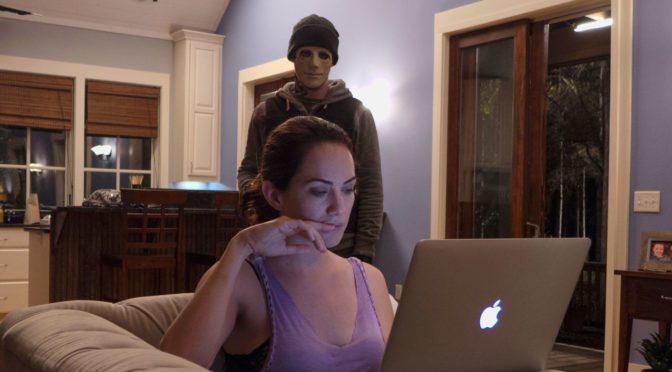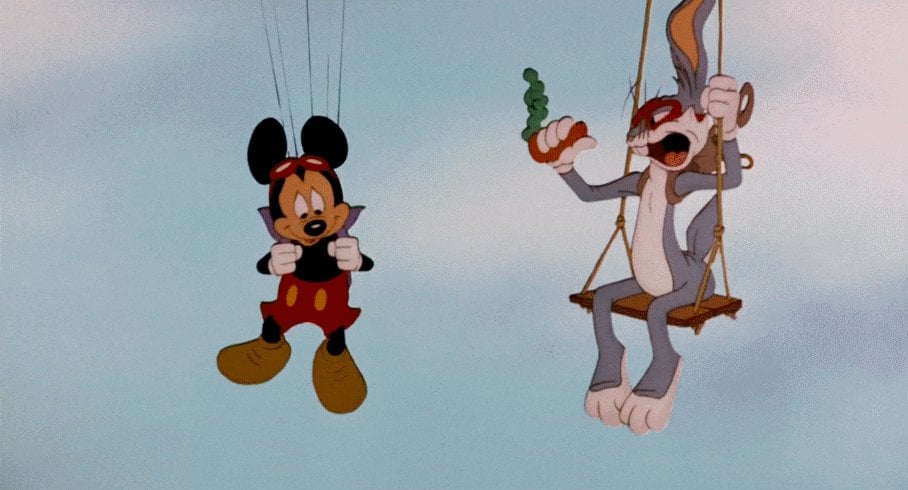“When you wish you were dead, that’s when I’ll come inside.”
Some horror films are great because of their underlying meanings, like how Rosemary’s Baby is about a woman trying to find her place in a world controlled by men, or how The Shining is about faking the moon landing, or expansionist genocide of Native Americans, depending on which part of Room 237 you’re watching. Some horror films are great because they have no deeper meaning; they’re content just to frighten and enrapture, and of these types of films, Hush is one of the best.
Directed by Mike Flanagan – whose work on this film and on Oculus is so good that it actually makes me want to see Oujia: Origin of Evil – Hush works wonders with a bare-bones story structure and a cast of only five. Maddie Young (Katie Siegel, who co-wrote the film with Flanagan) is an author, struggling with the ending of her novel, and living in a luxurious home in the middle of nowhere. For no reason, she finds herself being menaced in her home by a masked killer, and is forced to fend him off. The main difference between Maddie and other horror movie heroines is that Maddie is deaf, which makes Hush a tense, riveting riff on Wait Until Dark.
The film is minimalist down to its motivation. The killer – played by John Gallagher Jr. and credited only as “Man” – is given no backstory beyond a tattoo on his neck. While motiveless malice isn’t new to horror (one could argue it dates back to Othello), it can easily turn into artless nihilism if we’re not given a reason to care about the characters (which is why this film is so much better than The Strangers, which operates in a similar mode). The killer’s mask eschews the garish smiley faces or animal heads of The Purge or You’re Next; it’s adorned by no more than a quizzical half-smile, as if the killer were motivated by nothing more profound than curiosity: Can I kill this?
Setups like this are usually referred to as cat and mouse games, and while the phrase is apt, to an extent, it’s not totally accurate. Both Maddie and the killer are competent (to a degree), neither is invincible. Maddie doesn’t have a background as a Krav Maga fighter or an Eagle Scout or some other horror film contrivance, and the killer isn’t some sadistic mastermind. Several times, Maddie is able to fool or confuse him, which helps put them on even ground.
Siegel is flat-out terrific in this. She speaks no dialogue (outside of what you might call a fantasy sequence), but commands the screen nonetheless. Hush uses silence so well that in many ways it’s a silent film, with Siegel up to the task of conveying thoughts and emotions with nothing but her expressive eyes. The silence is more than a gimmick, though; sometimes it’s a by-product of the film’s minimalist construction, other times it serves as Flanagan’s way to put the viewer in her shoes. It produces some jump scares that actually feel earned. Jump scares are on thing, though, and Hush wouldn’t be as effective if it relied solely upon them. Where the film really succeeds is in its white-knuckle tension.
Maddie makes repeated escape attempts, some more successful than others. Hush doesn’t let her off the hook; she takes a crossbow bolt to the leg and later gets her hand smashed in a door before the killer breaks her fingers. Her pain is realistic and uncomfortable, and Flanagan wisely keeps Maddie from ever screaming; the silent agony written on Siegel’s face is another silent-movie touch that works wonders here. The killer’s vulnerability is important, too; Maddie hooks his forearm with the clawed end of a hammer, and later gets him in the shoulder with the crossbow. When her neighbor John (Michael Trucco) stops by, the killer has to stab him in the neck when he’s distracted by Maddie. He knows that physically he’s no match for John. (In another nice bit of characterization, we see the killer taking John’s watch and pocketing it.)
Hush respects but doesn’t romanticize Maddie. She cuts her hands severely trying to load the crossbow, and doesn’t even get the kill shot she needs to end the nightmare. She has no illusions about her chances of survival, and after taunting the killer to come in the house, she writes a description of him and a short goodbye note on her laptop (she signs off with “Died fighting,” the rare line that is actually better because the actress doesn’t speak it). The climactic fight is brutal and unforgiving, but Maddie gives as good as she gets.
Hush is a lean 80 minutes, and doesn’t need to be a single second longer. It’s a nasty little thriller (which the film references with a shot of Stephen King’s Mr. Mercedes on Maddie’s bookshelf; like the killer in Hush, King’s Brady Hartsfield reveals very little motive for his crimes) that expertly retains its tension. Flanagan’s direction is relentless, elevated by the Siegel and Gallagher Jr. Microbudget horror films in the mold of Hush come out every year, but they’re rarely this good.
10/1: Dawn of the Dead (2004)
10/2: The Exorcist
10/3: Pontypool
10/4: Hocus Pocus
10/5: The Orphanage
10/6: Rosemary’s Baby
10/7: Alien
10/8: Scream series
10/9: Scream series
10/10: Cujo
10/11: The Cabin in the Woods
10/12: Pulse
10/13: The Babadook
10/14: Friday the 13th
10/15: The Last House on the Left (both versions)
10/16: The Thing (both versions)
10/17: Little Shop of Horrors
10/18: Hush
10/19: Silent Hill
10/20: The Shining
10/21: Funny Games (2007)
10/22: Evil Dead series
10/23: Evil Dead series
10/24: The Mist
10/25: The Ninth Gate
10/26: The Fly
10/27: A Nightmare on Elm Street
10/28: The Nightmare Before Christmas
10/29: 28 Days Later/28 Weeks Later
10/30: It
10/31: Halloween (either version)










